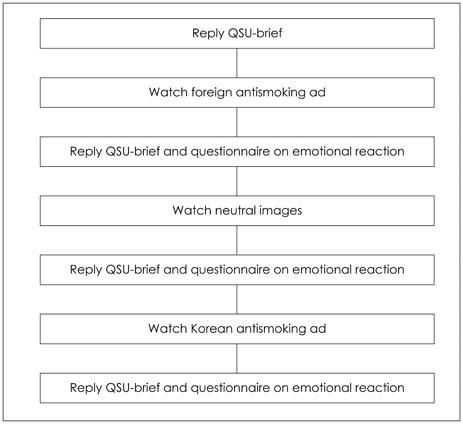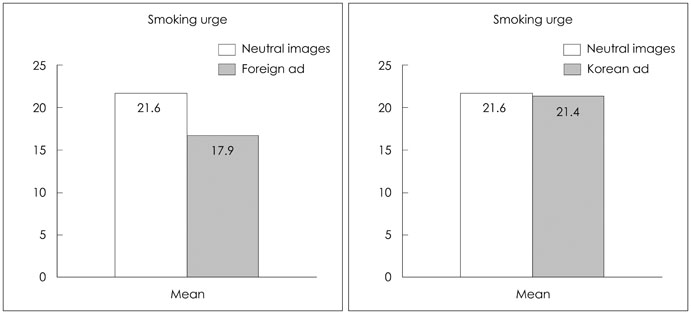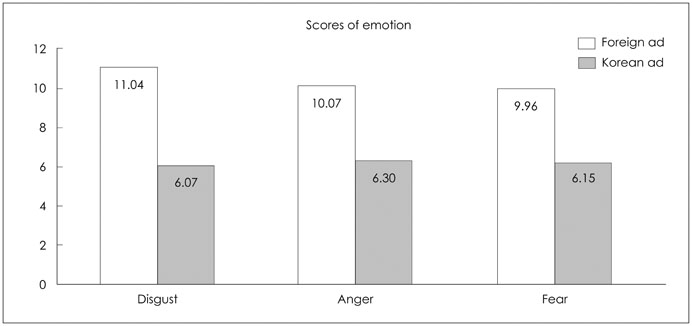J Korean Neuropsychiatr Assoc.
2016 Aug;55(3):264-270. 10.4306/jknpa.2016.55.3.264.
The Inhibitory Effect of Korean Antismoking Advertisement on Smoking Urge
- Affiliations
-
- 1Department of Psychiatry, College of Medicine, The Catholic University of Korea, Seoul St. Mary's Hospital, Seoul, Korea. neominnie@daum.net
- 2Department of Psychiatry, Naju National Hospital, Naju, Korea.
- KMID: 2351553
- DOI: http://doi.org/10.4306/jknpa.2016.55.3.264
Abstract
OBJECTIVES
This study compares the emotional reaction and inhibitory effect on smoking urge between foreign antismoking advertisements and Korean antismoking advertisements.
METHODS
Twenty-seven male smokers responded to a self-report survey including a Questionnaire on Smoking Urge and on emotional reactions such as disgust, anger and fear after watching a foreign antismoking advertisement, neutral images, and a Korean antismoking advertisement. We compared the smoking urge between the foreign antismoking advertisement and Korean antismoking advertisement and investigated emotional reactions associated with reduction in the smoking urge.
RESULTS
The foreign antismoking advertisement inhibited the smoking urge but Korean antismoking advertisement did not. A significantly higher emotional response was evoked by the antismoking advertisements than in neutral images. However, among the emotions respondents reported about the foreign antismoking advertisement, only disgust was significantly associated with smoking urge.
CONCLUSION
These results support published research, in that warning labels with high-rated emotional reactions are associated with reduction in the smoking urge. High emotional reactions such as disgust may enhance the effect of Korean antismoking advertisements.
Keyword
Figure
Reference
-
1. Organization for Economic Cooperation and Development. OECD health statistics 2014. Paris: Organization for Economic Cooperation and Development;2014.2. Hammond D. Health warning messages on tobacco products: a review. Tob Control. 2011; 20:327–337.
Article3. Hammond D, Fong GT, McNeill A, Borland R, Cummings KM. Effectiveness of cigarette warning labels in informing smokers about the risks of smoking: findings from the International Tobacco Control (ITC) Four Country Survey. Tob Control. 2006; 15:Suppl 3. iii19–iii25.
Article4. Food and Drug Administration, HHS. Required warnings for cigarette packages and advertisements. Final rule. Fed Regist. 2011; 76:36628–36777.5. R.J. Reynolds Tobacco Co. v. U.S. Food & Drug Administration, 696 F.3d 1205 (D.C. Cir. 2012). cited 2016 Mar 6. Available from: http://publichealthlawcenter.org/content/rj-reynolds-tobacco-co-vus-food-drug-administration.6. Thrasher JF, Rousu MC, Hammond D, Navarro A, Corrigan JR. Estimating the impact of pictorial health warnings and "plain" cigarette packaging: evidence from experimental auctions among adult smokers in the United States. Health Policy. 2011; 102:41–48.
Article7. Hitchman SC, Driezen P, Logel C, Hammond D, Fong GT. Changes in effectiveness of cigarette health warnings over time in Canada and the United States, 2002-2011. Nicotine Tob Res. 2014; 16:536–543.
Article8. Nan X, Zhao X, Yang B, Iles I. Effectiveness of cigarette warning labels: examining the impact of graphics, message framing, and temporal framing. Health Commun. 2015; 30:81–89.
Article9. Kees J, Burton S, Andrews JC, Kozup J. Understanding how graphic pictorial warnings work on cigarette packaging. J Public Policy Mark. 2010; 29:265–276.
Article10. Leshner G, Bolls P, Thomas E. Scare' em or disgust 'em: the effects of graphic health promotion messages. Health Commun. 2009; 24:447–458.
Article11. Hammond D, Fong GT, McDonald PW, Brown KS, Cameron R. Graphic Canadian cigarette warning labels and adverse outcomes: evidence from Canadian smokers. Am J Public Health. 2004; 94:1442–1445.
Article12. Cox LS, Tiffany ST, Christen AG. Evaluation of the brief questionnaire of smoking urges (QSU-brief) in laboratory and clinical settings. Nicotine Tob Res. 2001; 3:7–16.
Article13. Nabi RL. The theoretical versus the lay meaning of disgust: implications for emotion research. Cogn Emot. 2002; 16:695–703.
Article14. Dillard JP, Anderson JW. The role of fear in persuasion. Psychol Mark. 2004; 21:909–926.
Article15. Dillard JP, Plotnick CA, Godbold LC, Freimuth VS, Edgar T. The multiple affective outcomes of AIDS PSAs: fear appeals do more than scare people. Commun Res. 1996; 23:44–72.16. Choi YJ. An exploratory study of the effectiveness of cigarette warning label : on the basis of the effects of fear, disgust, anger on attitudes and behavioral intention. J Public Relat. 2014; 18:151–187.17. Terry-McElrath Y, Wakefield M, Ruel E, Balch GI, Emery S, Szczypka G, et al. The effect of antismoking advertisement executional characteristics on youth comprehension, appraisal, recall, and engagement. J Health Commun. 2005; 10:127–143.
Article18. Wakefield M, Durrant R, Terry-McElrath Y, Ruel E, Balch GI, Anderson S, et al. Appraisal of anti-smoking advertising by youth at risk for regular smoking: a comparative study in the United States, Australia, and Britain. Tob Control. 2003; 12:Suppl 2. ii82–ii86.
Article19. Wang AL, Lowen SB, Romer D, Giorno M, Langleben DD. Emotional reaction facilitates the brain and behavioural impact of graphic cigarette warning labels in smokers. Tob Control. 2015; 24:225–232.
Article20. Sabbane LI, Lowrey TM, Chebat JC. The effectiveness of cigarette warning label threats on nonsmoking adolescents. J Consum Aff. 2009; 43:332–345.
Article21. Petersen LE, Lieder F. The effectiveness of written and graphic health warnings on cigarette packs: an examination of the revised model of protection motivation. Zeitschrift für Sozialpsychologie. 2006; 37:245–258.
Article




